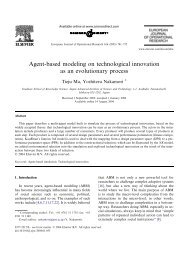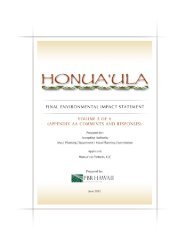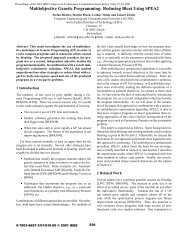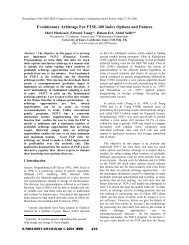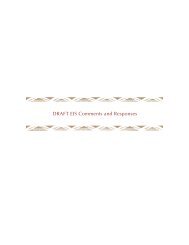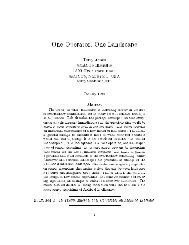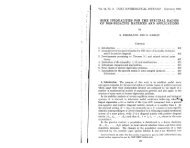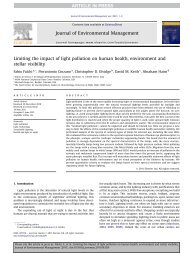4 description of the human environment, potential ... - Lee Altenberg
4 description of the human environment, potential ... - Lee Altenberg
4 description of the human environment, potential ... - Lee Altenberg
You also want an ePaper? Increase the reach of your titles
YUMPU automatically turns print PDFs into web optimized ePapers that Google loves.
Final Environmental Impact Statement<br />
Regional and local climate, toge<strong>the</strong>r with <strong>the</strong> amount and type <strong>of</strong> <strong>human</strong> activity,<br />
generally dictate <strong>the</strong> air quality <strong>of</strong> a given location. The climate in <strong>the</strong> vicinity <strong>of</strong><br />
, <strong>the</strong> area <strong>of</strong> <strong>the</strong> widening <strong>of</strong> Piÿilani Highway, <strong>the</strong> Wailea Ike Drive and Wailea<br />
Alanui Drive intersection, and <strong>the</strong> areas <strong>of</strong> <strong>the</strong> <strong>of</strong>f-site water and wastewater infrastructure<br />
is very much affected by its <strong>the</strong> elevation near sea level and by nearby mountains.<br />
Haleakalä shelters <strong>the</strong> area from <strong>the</strong> nor<strong>the</strong>ast trade winds, and local winds (such as<br />
land/sea breezes and upslope/downslope winds) affect <strong>the</strong> wind flow in <strong>the</strong> area much <strong>of</strong><br />
<strong>the</strong> time. Temperatures in <strong>the</strong> area are generally very consistent and warm with average<br />
daily temperatures ranging from about 63 F to 86 F.<br />
Both Federal and State standards have been established to maintain ambient air quality. At<br />
<strong>the</strong> present time, seven parameters are regulated: 1) particulate matter, 2) sulfur dioxide, 3)<br />
hydrogen sulfide, 4) nitrogen dioxide, 5) carbon monoxide, 6) ozone and 7) lead. Hawaii<br />
air quality standards are comparable to <strong>the</strong> national standards except those for nitrogen<br />
dioxide and carbon monoxide, which are more stringent than <strong>the</strong> national standards.<br />
POTENTIAL IMPACTS AND MITIGATION MEASURES<br />
, <strong>the</strong> widening <strong>of</strong> Piÿilani Highway, <strong>the</strong> Wailea Ike Drive and<br />
Wailea Alanui Drive intersection improvements, and <strong>the</strong> areas <strong>of</strong> <strong>the</strong> <strong>of</strong>f-site water and<br />
wastewater infrastructure may result in short- and long-term impacts on air quality, ei<strong>the</strong>r<br />
directly or indirectly, as a consequence <strong>of</strong> construction and occupancy use. However, it is<br />
anticipated that no State or Federal air quality standards will be violated during or after <strong>the</strong><br />
construction. After build-out, air quality in <strong>the</strong> vicinity vicinities , <strong>the</strong><br />
widened Piÿilani Highway, <strong>the</strong> Wailea Alanui Drive intersection, and <strong>the</strong> <strong>of</strong>f-site water and<br />
wastewater infrastructure primarily will be affected by vehicular emissions associated with<br />
additional traffic.<br />
Short-term Impacts Short-term impacts from fugitive dust will likely occur during<br />
construction. Construction will include earthmoving activity, excavating, trenching, and<br />
filling. To a lesser extent, exhaust emissions from stationary and mobile construction<br />
equipment, from disruption <strong>of</strong> traffic, and from workers vehicles may also affect air<br />
quality during construction.<br />
A dust Dust control plans will be<br />
implemented during all construction phases. All construction activities, including<br />
construction <strong>of</strong> <strong>the</strong> Wailea Ike Drive and Wailea Alanui Drive intersection improvements<br />
and <strong>the</strong> <strong>of</strong>f-site water and wastewater infrastructure will comply with <strong>the</strong> provisions <strong>of</strong><br />
Chapter 11-60.1-33, HAR on fugitive dust. Measures to control dust during construction<br />
may include:<br />
Planning phases <strong>of</strong> construction to minimize <strong>the</strong> amount <strong>of</strong> dust-generating<br />
materials and activities, centralizing on-site vehicular traffic routes, and locating<br />
<strong>potential</strong> dust-generating equipment in areas <strong>of</strong> least impact;<br />
Watering active work areas and any temporary unpaved work roads daily;<br />
CHAPTER 4 DESCRIPTION OF THE HUMAN ENVIRONMENT, POTENTIAL IMPACTS, AND MITIGATION MEASURES<br />
144



